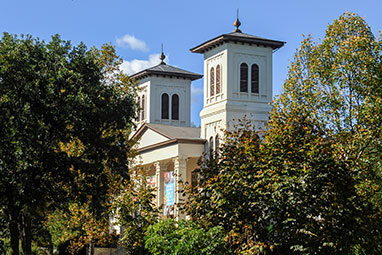SPARTANBURG, S.C. – Wofford College improved its already high ranking among Kiplinger’s Personal Finance magazine’s list of the Top 300 Best College Values of 2017, moving up to #109 and remaining the top South Carolina institution on the overall list as well as the list of national liberal arts colleges.
In 2016, Wofford ranked #116 on the overall list that also includes public and private universities. This year, Wofford is ranked #57 among liberal arts colleges, up from #61 last year.
Introduced in 1998, the rankings now include public and private universities and private liberal arts colleges that combine outstanding academics with affordable cost into a single, comprehensive list. Kiplinger also ranks the top 100 best values in each category.
“Kiplinger’s ranking of Wofford as a best value college continues to reflect our long-term commitment to balancing two important priorities: offering an outstanding residential academic program and focusing on affordability for a wide range of students and their families,” Wofford President Nayef Samhat says. “We consistently are listed among the best value colleges in a number of national college guides and publications, including Forbes, U.S. News & World Report, Princeton Review and Money magazine.”
Wofford has appeared on Kiplinger’s best value list since 2008, the second year the publication began its annual rankings. The combined list of public and private universities with liberal arts colleges debuted last year.
“There’s no way around it: College is expensive, and it’s going to stay that way for a long time,” says Janet Bodnar, editor of Kiplinger’s Personal Finance magazine. “With our rankings – which weigh affordability alongside academic quality – our goal is to help students and their parents understand what’s really worth the price. While some may have ranked higher than others, all 300 schools on the list are of extraordinary value, chosen out of a universe of 1,200.”
Kiplinger’s quality measures, which are weighted more heavily than cost, include the admission rate, the percentage of students who return for their sophomore year, the student-faculty ratio and the four-year graduation rate. Cost criteria include sticker price, financial aid and average debt at graduation. Unlike other rankings, which include subjective criteria in their assessments, Kiplinger restricts its analysis to measurable standards of academic quality and affordability. Kiplinger’s was the first ranking to focus on value, its core mission.
At Kiplinger.com, visitors can access the “Find the Best College for You” tool and other tools that allow readers to sort by admission rate, average debt at graduation and other criteria for all schools, plus in-state and out-of-state costs for public universities.
The complete rankings are available online at kiplinger.com/links/colleges and will appear in print in the February 2017 issue of Kiplinger’s Personal Finance, on newsstands on Jan. 3, 2017.
Wofford named a 2017 ‘Best College Value’ by Kiplinger’s Personal Finance
Top S.C. college among all ranked institutions, list of liberal arts colleges
Wofford consistently is listed among the country's top "best value" colleges.
2016-12-15